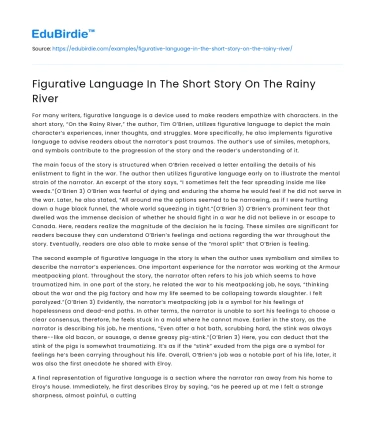For many writers, figurative language is a device used to make readers empathize with characters. In the short story, “On the Rainy River,” the author, Tim O’Brien, utilizes figurative language to depict the main character’s experiences, inner thoughts, and struggles. More specifically, he also implements figurative language to advise readers about the narrator’s past traumas. The author’s use of similes, metaphors, and symbols contribute to the progression of the story and the reader’s understanding of it.
The main focus of the story is structured when O’Brien received a letter entailing the details of his enlistment to fight in the war. The author then utilizes figurative language early on to illustrate the mental strain of the narrator. An excerpt of the story says, “I sometimes felt the fear spreading inside me like weeds.”(O’Brien 3) O’Brien was fearful of dying and enduring the shame he would feel if he did not serve in the war. Later, he also stated, “All around me the options seemed to be narrowing, as if I were hurtling down a huge black funnel, the whole world squeezing in tight.”(O’Brien 3) O’Brien’s prominent fear that dwelled was the immense decision of whether he should fight in a war he did not believe in or escape to Canada. Here, readers realize the magnitude of the decision he is facing. These similes are significant for readers because they can understand O’Brien’s feelings and actions regarding the war throughout the story. Eventually, readers are also able to make sense of the “moral split” that O’Brien is feeling.
Save your time!
We can take care of your essay
- Proper editing and formatting
- Free revision, title page, and bibliography
- Flexible prices and money-back guarantee
The second example of figurative language in the story is when the author uses symbolism and similes to describe the narrator’s experiences. One important experience for the narrator was working at the Armour meatpacking plant. Throughout the story, the narrator often refers to his job which seems to have traumatized him. In one part of the story, he related the war to his meatpacking job, he says, “thinking about the war and the pig factory and how my life seemed to be collapsing towards slaughter. I felt paralyzed.”(O’Brien 3) Evidently, the narrator’s meatpacking job is a symbol for his feelings of hopelessness and dead-end paths. In other terms, the narrator is unable to sort his feelings to choose a clear consensus, therefore, he feels stuck in a mold where he cannot move. Earlier in the story, as the narrator is describing his job, he mentions, “Even after a hot bath, scrubbing hard, the stink was always there--like old bacon, or sausage, a dense greasy pig-stink.”(O’Brien 3) Here, you can deduct that the stink of the pigs is somewhat traumatizing. It’s as if the “stink” exuded from the pigs are a symbol for feelings he’s been carrying throughout his life. Overall, O’Brien’s job was a notable part of his life, later, it was also the first anecdote he shared with Elroy.
A final representation of figurative language is a section where the narrator ran away from his home to Elroy’s house. Immediately, he first describes Elroy by saying, “as he peered up at me I felt a strange sharpness, almost painful, a cutting sensation if his gaze were somehow slicing me open.”(O’Brien 5) When O’Brien went to Elroy’s house, it was a big turning point in the story. It was a big turning point in the story when O’Brien went to Elroy’s house. Towards the end of the book, Elroy silently confronts O’Brien and attempts to make him decide whether or not he is going to run away from the war. Right from the beginning, we are informed that Elroy can see through O’Brien’s insecurities. The character Elroy plays a fundamental role in the plot. As the story progresses, the author also writes, “He was the true audience. He was a witness, like God or like the gods, who look on in absolute silence as we live our lives, as we make out choices or fail to make them.”(O’Brien 11) In contrast to the way the narrator originally described Elroy, the narrator speaks of Elroy as if he is someone who’s given him guidance. It seems that Elroy is indifferent about O’Brien’s dilemma, and he is simply letting O’Brien make his own choice while still offering silent support. In general, the figurative language relating to Elroy’s character supports the idea that Elroy is a character understands O’Brien and greatly aids O’Brien in his time of hardship.
All in all, figurative language is a crucial element in the short story, “On the Rainy River.” Tim O’Brien incorporated multiple uses of figurative language to enhance his feelings and experiences. When they are brought together, it makes a considerable impact when getting to know the characters better. In the end, O’Brien’s implementation of metaphors, similes, and symbolism created an immersing, complex story.






 Stuck on your essay?
Stuck on your essay?

